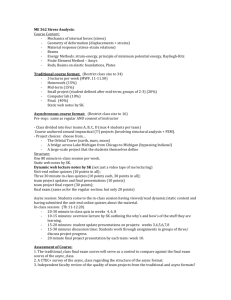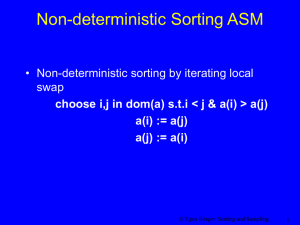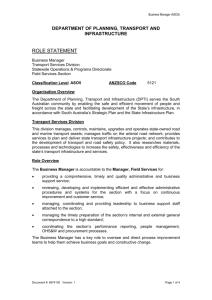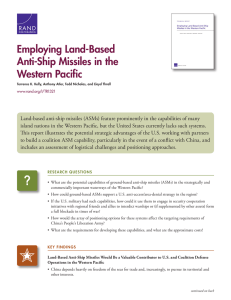AsyncASM.ppt
advertisement
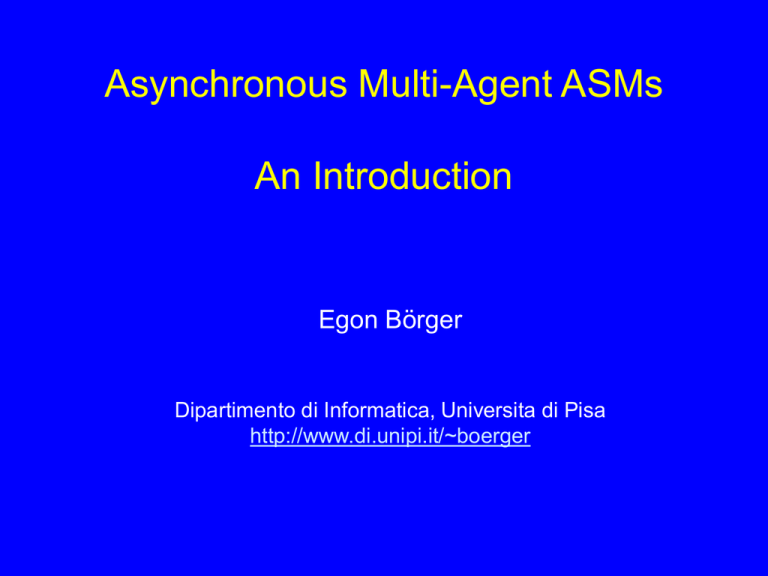
Asynchronous Multi-Agent ASMs
An Introduction
Egon Börger
Dipartimento di Informatica, Universita di Pisa
http://www.di.unipi.it/~boerger
For details see Chapter 2 (Asynchronous Multi-Agent
ASMs) of:
E. Börger, R. Stärk
Abstract State Machines
A Method for High-Level System Design and Analysis
Springer-Verlag 2003
For update info see AsmBook web page:
http://www.di.unipi.it/AsmBook
© Egon Börger: Introduction to Async ASMs
2
• Definition of Async ASMs
• Small Examples
– Mutual Exclusion
• Dining Philosophers
• Multiple Read One Write
– Network Algorithms
• Master Slave
• Consensus
• Load Balance
• Leader Election
• Echo
• Phase Synchronization
• Simple Properties of Async ASMs
• References
© Egon Börger: Introduction to Async ASMs
3
Recalling Basic ASMs: computation step
• Basic ASM: a finite set of rules, executed by a single
agent self, of form
– If Condition Then Updates
• A computation step of a basic ASM:
• In the current state (well-defined global structure) S:
– determine all the fireable rules in S (s.t. Cond is true in S)
– compute all expressions ti,t occurring in updates
f(t1,…,tn):=t
• this includes reading of the monitored functions,
supposed to have well-defined stable values for
each execution step
• execute simultaneously all these function updates
© Egon Börger: Introduction to Async ASMs
4
Recalling Basic ASMs: next state
• The updating yields a next state S’, which is
well-defined by the updates - and by possible
changes of the monitored function values,
thought of as resulting from implicit actions of
the environment
– environment actions are assumed to be “located”
with respect to a machine step in such a way that
their result is ready when the machine is going to
perform its next step (implicit environment-controller
separation principle)
© Egon Börger: Introduction to Async ASMs
5
Distributed Runs: State Stability Problem
• In runs of asynchronously cooperating independent
agents, the possible incomparability of moves coming with different data, clocks, moments and
duration of execution - makes it difficult
– to uniquely define a global state where moves are
executed
– to locate changes of monitored fcts in the ordering
of moves
• The coherence condition in the definition of
asynchronous multi-agent ASM runs below postulates
well-definedness for a relevant portion of state in
which an agent is supposed to perform a step, thus
providing a notion of “local” stable view of “the”
idealized state in which an agent makes a move.
© Egon Börger: Introduction to Async ASMs
6
Async ASM Runs: Environmental Changes
• Changes of monitored functions can be made
explicit as resulting from moves of one or
more environment agents.
– Such monitored moves - moves of “unkown”
agents, as opposed to the controlled moves of
the explicitly given agents - are often thought of
as implicitly given, e.g. by speaking of “time
moments” in which changes of monitored
functions take place.
© Egon Börger: Introduction to Async ASMs
7
Defining Asynchronous Multi-Agent ASMs
• An Async ASM is a family of pairs (a, ASM(a)) of
– agents a Agent (a possibly dynamic set)
– basic ASMs ASM (a)
• A Run of an async ASM is a partially ordered set (M, < ) of
“moves” m of its agents s.t.:
– finite history: each move has only finitely many
predecessors, i.e. {m’ | m’ < m } is finite for each mM
– sequentiality of agents: for each agent a Agent, his
moves {m | mM, a performs m} are linearly ordered by <
– coherence: each (finite) initial segment X of (M, < ) has an
associated state (X) – think of it as the result of all moves
in X with m executed before m’ if m<m’– which for every
maximal element mX is the result of applying move m in
state (X-{m})
© Egon Börger: Introduction to Async ASMs
8
Linearizing Initial segments of runs of an async ASM
• Linearization Lemma. Let X be a finite
initial segment (downward closed subset)
of a run of an async ASM. Each
linearization of X yields a run with the same
final state.
• Proof: follows from the coherence condition
© Egon Börger: Introduction to Async ASMs
9
• Definition & Simple Properties of Async ASMs
• Small Examples
– Mutual Exclusion
• Dining Philosophers
• Multiple Read One Write
See Reisig 1998, Sect. 10
– Network Algorithms
• Master Slave
• Consensus
• Load Balance
• Leader Election
• Echo
• Phase Synchronization
• Exercises and References
© Egon Börger: Introduction to Async ASMs
10
Exclusive use of shared resources: problem statement
• Goal: Design a distributed algorithm that
– allows every interested agent to eventually use
some shared resource in exclusive use
– prevents two users to use the shared resource
simultaneously
• Agent: set of agents each equipped with
– resource: Resource (different agents may have
the same resource)
• owner: Resource Agent
recording the
current user of a given resource
© Egon Börger: Introduction to Async ASMs
11
Exclusive use of shared resources: single agent view
• The algorithm has to manipulate updates of owner
in such a way that every attempt by an agent to
become owner of his resource will eventually
succeed
• Every single agent would like to execute alternately
the following two rules:
if owner(resource) = none
then owner(resource):= self
if owner(resource) = self
then owner(resource):= none
Conflicts in using resource shared among different agents are
risolved by defining a partial order among possibly conflicting
moves in an (appropriately initialized) run of an async ASM.
Realizing such an order reflects appropriate scheduling and
priority policies.
© Egon Börger: Introduction to Async ASMs
12
Dining Philosophers
illustrating exclusive use of shared resources
Shared resources represented as “forks” used by “philosophers”
Resource assigning function F: depends on the neighbourhood in the underlying graph
e.g. each agent may have one left and one right neighbour sharing the resource:
Fork = (leftF,rightF) with elementwise defined owner
rightF
leftF
phil
if owner(leftF) = owner(rightF) = none
then owner(leftF):= self
owner(rightF):= self
if owner(leftF) = owner(rightF) = self
then owner(leftF):= none
owner(rightF):= none
© Egon Börger: Introduction to Async ASMs
13
• Definition of Async ASMs
• Small Examples
– Mutual Exclusion
• Dining Philosophers
• Multiple Read One Write See Reisig 1998, Sect. 24
– Network Algorithms
• Master Slave
• Consensus
• Load Balance
• Leader Election
• Echo
• Phase Synchronization
• Simple Properties of Async ASMs
• References
© Egon Börger: Introduction to Async ASMs
14
Multiple Reads One Write : problem statement
(non-exclusive and exclusive resource sharing)
• Goal: Design a distributed algorithm allowing
at each step one agent to start a read or a
write operation in a given file, up to maxread>0 simultaneous reads but only 1 write
(not overlapping with any read)
– Below we define agent rules for read/write access
to files which in a distributed run of an async ASM
(of agents all of which are equipped with those
rules) reach the requested goal
• NB. In the example we do not define the partial order for
such distributed runs.
© Egon Börger: Introduction to Async ASMs
15
Multiple Reads One Write : Agent Signature
• Agent : set of agents which are allowed
to access files for read/write operations
– finished:File Bool indicating whether an agent
has finished his current file operation
• File: set of files equipped with
– user : Nat indicating the number of agents which
are currently reading or writing the file
– max-read,max-write maximal number of agents
allowed to simultaneously use the file for
reading/writing
© Egon Börger: Introduction to Async ASMs
16
Multiple Reads One Write: agent rules for act=read/write
actwait
act-increase
user (file)
act-accessible(file)
act-decrease
user (file)
act-accessible(file)
user (file) < max-act (file)
finished(file)
max-write(file) = 1
write-in/decrease user(file)
user (file):= user(file) 4
act
max-read (file) = 4
write-in/decrease user(file)
user (file):= user(file) 1
If instead of 1 one wants to allow multiple simultaneous file access attempts,
max-read becomes a cumulative counter to have the expected overall effect
read-accessible (file) becomes user (file) + newUsers max-act (file)
where newUsers indicates the number of users attempting to access the file for reading
© Egon Börger: Introduction to Async ASMs
17
• Definition of Async ASMs
• Small Examples
– Mutual Exclusion
• Dining Philosophers
• Multiple Read One Write
– Network Algorithms
• Master Slave Agreement
• Consensus
• Load Balance
See Reisig 1998, Sect. 30 (Fig.30.1), 75
• Leader Election
• Echo
• Phase Synchronization
• Simple Properties of Async ASMs
• References
© Egon Börger: Introduction to Async ASMs
18
Master/Slave Agreement : problem statement
• Goal: Design a distributed algorithm for a master
launching orders to slave agents, to be confirmed by
them and to be executed iff all of them confirm to the
master the acceptance of the order.
• Algorithmic Idea:
– the master enquires about a job to be launched and then
waits for answers from the slaves
– the slaves answer the enquiry and then wait for the order or
the cancellation of the launched job from the master
– the master orders or cancels the job depending on whether
all slaves answered to accept it or not
• Eventually the master becomes idle, with all slaves
either idle too or executing the accepted job.
© Egon Börger: Introduction to Async ASMs
19
Master/Slave Agreement : Agent Signature
• master: a distinguished agent
– order: Order external function yielding jobs to be sent to
the slaves
– ctl_state: {idle, waitingForAnswer}
• Slaves:
a set of agents equipped with
– asked: {true,false} recording whether a job request has
been launched by the master to the slave
– answer : {accept,refuse,undef} recording whether a job
request has been acceped by the slave
– ctl_state:{idle, waitingForOrder, busy}
• Initially ctl_state = idle, order = answer =undef, asked = false
• NB. Abstraction from message passing: functions asked, answer, order
shared in writing resp.reading among slaves and master
© Egon Börger: Introduction to Async ASMs
20
Master/Slave Agreement ASMs
waiting
For
Answer
Enquire
idle
Enquire forall s Slave s.asked := true
Answers Arrived forall s Slave
s.answer {accept, refuse}
idle
Answer
waiting
For
Order
Answers
Arrived
OrderOr
Cancel
OrderOrCancel
clear answer
if for some s Slave s.answer = refuse
then order:=cancel
else order:=job
Order
Arrived
order
= job
yes
busy
no
done
Answer if asked then
choose r {accept, refuse}
answer:=r
asked:=false
OrderArrived order { job, cancel }
© Egon Börger: Introduction to Async ASMs
21
Master/Slave Agreement Correctness
• Proposition: In every run of a set of master and
slaves, all equipped with the corresponding
master/slave ASM, after the master has
started an Enquiry, eventually the master
becomes idle and
– either all slaves become done or
– all slaves become busy executing the job ordered
by the master
• Proof. Follows by run induction.
© Egon Börger: Introduction to Async ASMs
22
• Definition of Async ASMs
• Small Examples
– Mutual Exclusion
• Dining Philosophers
• Multiple Read One Write
– Network Algorithms
• Master Slave
• Consensus See Reisig 1998, Sect. 35 (Fig. 35.1), 80
• Load Balance
• Leader Election
• Echo
• Phase Synchronization
• Simple Properties of Async ASMs
• References
© Egon Börger: Introduction to Async ASMs
23
Consensus in Networks: problem statement
• Goal: Design a distributed algorithm for
reaching consensus among homogeneous
agents of finite connected networks (using only
communication between neighbors, without
broker or mediator, with abstract requests and
answers).
• Algorithmic Idea: every agent (node) may
– launch a request to his neighbors and wait for the
replies
– agree with the replies received from his neighbors
– reply to requests received from his neighbors
• until all agents agree (maybe never)
© Egon Börger: Introduction to Async ASMs
24
Consensus ASM: Agent Signature
• Agent : finite connected set (of nodes)
• Each agent equipped with:
– neighb Agent
(external function)
– Request {RequestFrom(n)|nneighb }
(controlled function)
– Reply {ReplyFrom(n)|n neighb }
(controlled function)
– ctl_state : {pending, agreed}
• Initially ctl_state=pending, Request = empty, Reply = full
• chosenRule to control non-deterministic choice between
LaunchNewRequest and Answer
© Egon Börger: Introduction to Async ASMs
25
Consensus Control State ASM
chosenRule
= Answer
pending
yes
there are
requests
Answer
no
Expected
Replies
Complete
LaunchNew
Request
yes
chosenRule
= LaunchNew
Request
ExpectedRepliesComplete
Reply = full
no
LaunchNewRequest
Reply := empty
BroadcastRequest
BroadcastRequest forall n neighb
insert RequestFrom(self) into Request(n)
agreed
Answer
forall r Request do
delete r from Request
send answer for r
send answer for RequestFrom(n)
insert ReplyFrom(self) into Reply(n)
Variation: choose r Request ...
© Egon Börger: Introduction to Async ASMs
26
Async Consensus ASM : Stability property
• Proposition: In every distributed run of agents
equipped with the consensus ASM, if the run
terminates, then for every agent holds:
– ctl_state = agreed
– Reply = full
– Request = empty
• Proof (assuming that every enabled agent will
eventually make a move): follows from the
definition of LaunchNewRequest, Answer.
– When Reply=full at agent, then there is no
RequestFrom(agent) in Request(n) for any n
neighb(agent)
© Egon Börger: Introduction to Async ASMs
27
• Definition of Async ASMs
• Small Examples
– Mutual Exclusion
• Dining Philosophers
• Multiple Read One Write
– Network Algorithms
• Master Slave
• Consensus
• Load Balance See Reisig 1998, Sect. 37 (Fig.37.1), 82
• Leader Election
• Echo
• Phase Synchronization
• Simple Properties of Async ASMs
• References
© Egon Börger: Introduction to Async ASMs
28
Ring Load Balance: problem statement
• Goal: Design a distributed algorithm for reaching
workload balance among the agents of a ring (using
only communication between right/left neighbors)
– keeping message passing mechanism and effective task
transfer abstract, assuming fixed number of agents and
total workload
• Algorithmic Idea: every agent (ring node)
– alternately sends
• a workload info mssg to his right neighbor
• a task transfer mssg to his left neighbor, transfering a task to
balance the workload with the left neighbor
– updates his workload to balance it with his right neighbor
• so that eventually the difference between the
workload of two nodes becomes 1
– NB. Sending workload info mssg precedes task balancing
© Egon Börger: Introduction to Async ASMs
29
Ring Load Balance ASM: Agent Signature
• Agent : a ring of agents equipped with:
– leftNeighb, rightNeighb: Agent (external functions)
– workLoad: the current workload
– neighbLoad: current workload of leftNeighb
– transferLoad: workload transfered by rightNeighb
– ctl_state : {informRightNeighb,
checkWithLeftNeighb , checkWithRightNeighb }
• Initially
– ctl_state = informRightNeighb
– neighbLoad = transferLoad = undef
© Egon Börger: Introduction to Async ASMs
30
Ring Load Balance ASM
inform
Right
Neighb
Send(workLoad)
checkWith
Left
Neighb
BalanceWithLeftNeighb
BalanceWithRightNeighb
checkWith
Right
Neighb
BalanceWithRightNeighb
If arrived(transferLoad) then
accept task from rightNeighb
accept task from rightNeighb
workLoad:= workLoad + transferLoad
transferLoad:= undef
arrived(l) l undef
Send(workLoad)
rightNeighb.neighbLoad
:= workLoad
BalanceWithLeftNeighb
If arrived(neighbLoad) then
transfer task to leftNeighb
transfer task to leftNeighb
let transfer = workLoad > neighbLoad in
leftNeighb.transferLoad:= transfer
workLoad:= workLoad transfer
neighbLoad:= undef
© Egon Börger: Introduction to Async ASMs
31
Async Ring Load Balance ASM : Correctness
• Proposition: In every distributed run of agents
equipped with the ring load balance ASM,
eventually the workload difference between
two neighboring nodes becomes 1.
• Proof (assuming that every enabled agent will
eventually make a move): induction on the
wieght of run workload differences. Let w =
total workLoad of all nodes, a= |Agent|.
– Case 1: t|a. Then eventually workLoad(n)=w/a for
every node n.
– Case 2: otherwise. Then eventually the workLoad
of some neighboring nodes will differ by 1.
© Egon Börger: Introduction to Async ASMs
32
• Definition of Async ASMs
• Small Examples
– Mutual Exclusion
• Dining Philosophers
• Multiple Read One Write
– Network Algorithms
• Master Slave
• Consensus
• Load Balance
• Leader Election See Reisig 1998, Sect. 32 (Fig.32.1/2), 76
• Echo
• Phase Synchronization
• Simple Properties of Async ASMs
• References
© Egon Börger: Introduction to Async ASMs
33
Leader Election: problem statement
• Goal: Design a distributed algorithm for the election
of a leader in finite connected networks of
homogeneous agents, using only communication
(message passing) between neighbor nodes.
• Assumptions:
– network nodes (agents) are connected & linearly ordered
– leader = max (Agent) wrt the linear order <
• Algorithmic Idea: every agent (network node)
– proposes to his neighbors his current leader candidate
– checks the leader proposals received from his neighbors
• upon detecting a proposal which improves his leader candidate he
improves his candidate for his next proposal
• Eventually cand=max(Agent) holds for all agents
© Egon Börger: Introduction to Async ASMs
34
Leader Election: Agent Signature
• Agent : finite linearly ordered connected set
– < linear order of Agent (external function)
• leader = max (Agent) wrt the linear order <
• Each agent equipped with:
– neighb Agent
(external function)
– cand: Agent
(controlled function)
– proposals Agent
(controlled function)
– ctl_state : {proposeToNeighbors, checkProposals}
• Initially ctl_state=proposeToNeighbors, cand=self, proposals = empty
© Egon Börger: Introduction to Async ASMs
35
Leader Election Control State ASM
propose
To
Neighbors
propose
check
Proposals
improve by proposals
empty proposals
proposals
improve
there are
proposals
yes
no
empty proposals
propose forall n neighb
insert cand to proposals(n)
proposals improve max (proposals) > cand
improve by proposals cand := max (proposals)
© Egon Börger: Introduction to Async ASMs
36
Leader Election: Correctness property
• Proposition: In every distributed run of agents
equipped with the leader election ASM,
eventually for every agent holds:
– cand=max(Agent)
– ctl_state = checkProposals
– proposals = empty
• Proof (assuming that every enabled agent will
eventually make a move): induction on runs
and on {leader - cand(n)| n Agent}
– measuring “distances” of candidates from leader
© Egon Börger: Introduction to Async ASMs
37
Refining Leader Election: compute minimal path to leader
• Goal: refine the leader election algorithm to
compute for each agent also a shortest path to the
leader, providing
– a neighbor (except for leader) which is closest to the
leader
– the minimal distance to the leader
• Idea: enrich cand and proposals by neighbor with
minimal distance to leader:
– nearNeighb: Agent
– distance: Distance
(e.g. = Nat {})
– proposals: PowerSet(Agent x Agent x Distance)
• Initially
nearNeighbor = self
distance =0
© Egon Börger: Introduction to Async ASMs
38
ASM Computing Minimal Path To Leader
propose
To
Neighbors
propose
check
Proposals
improve by proposals
empty proposals
proposals
improve
there are
proposals
yes
no
empty proposals
propose forall n neighb
insert (cand, nearNeighb, distance) to proposals(n)
proposals improve let m = Max (proposals) in m > cand
or (m=cand and minDistance(proposalsFor m)+1 < distance)
update PathInfo to m
choose (n,d) with (m,n,d) proposals
d=minDistance(proposalsFor m) in
nearNeighb := n
distance := d+1
Max taken
over agents
improve by proposals
cand := Max (proposals)
update PathInfo to Max (proposals)
© Egon Börger: Introduction to Async ASMs
39
Minimal Path Computation: Correctness
• Proposition: In every distributed run of agents
equipped with the ASM computing a minimal path to
the leader, eventually for every agent holds:
– cand=max(Agent)=leader
– distance=minimal distance of a path from agent to leader
– nearNeighbor = a neighbor of agent on a minimal path to
the leader (except for leader where nearNeighbor=leader)
– ctl_state = checkProposals
– proposals = empty
• Proof (assuming that every enabled agent will
eventually make a move): induction on runs and on
{leader - cand(n)| n Agent} with side induction on
the minimal distances in proposalsFor
Max(proposals)
© Egon Börger: Introduction to Async ASMs
40
Exercises
• Refine the CHECK submachine of the leader
election ASM by a machine which checks proposals
elementwise. Prove that the refinement is correct.
– Hint: See Reisig op.cit. Fig.32.1
• Adapt the ASM for the election of a maximal leader
and for computing a minimal path wrt a partial order
instead of a total order.
• Reuse the leader election ASM to define an
algorithm which, given the leader, computes for
each agent the distance (length of a shortest path)
to the leader and a neighbor where to start a
shortest path to the leader.
– Hint: See Reisig op.cit. Fig.32.2
© Egon Börger: Introduction to Async ASMs
41
• Definition of Async ASMs
• Small Examples
– Mutual Exclusion
• Dining Philosophers
• Multiple Read One Write
– Network Algorithms
• Master Slave
• Consensus
• Load Balance
• Leader Election
• Echo See Reisig 1998, Sect. 33, 77
• Phase Synchronization
• Simple Properties of Async ASMs
• References
© Egon Börger: Introduction to Async ASMs
42
Echo Algorithm : problem statement
• Goal: Design a distributed algorithm that guarantees
an initiator’s message being broadcast and
acknowledged (‘echoed’) through a finite connected
network, using only communication between
neighbors
• Algorithmic Idea:
– the initiator (a distinguished node) broadcasts an info to all
his neighbors and waits for their acknowledgements
– every node which has been informed by some neighbor
(‘parent’) node informs all his other neighbor nodes and
waits for their acknowledgements to come back, to then
forward his own acknowledgement back to the parent node
© Egon Börger: Introduction to Async ASMs
43
Echo ASM: Agent Signature
• Agent : connected graph of agents
– initiator: Agent distinguished element with control states
{broadcast, waitingForEcho, echoArrived} and special ASM
• Each agent is equipped with:
– neighb Agent
– informedBy : Agent Bool
(external function)
(abstract message passing)
• indicating whether a message (with info or acknowledgement) from
a neighbor agent has been sent (arrived)
– parent : Agent
(building a spanning tree for acks)
• yields a neighbor node who has sent a messg which is to be
acknowledged, once all other neighbor nodes have acknowledged
this mssg which has been forwarded to them
– ctl_state:{listeningToInfo,waitingForAck,informed }
• Initially initiator in ctl_state = broadcast, for all other agents:
– ctl_state = listeningToInfo, informedBy everywhere false, parent = undef
© Egon Börger: Introduction to Async ASMs
44
Initiator ASM for Echo algorithm
broad
cast
InformAll
Neighbors
waiting
For
Echo
InformAllNeighbors forall u neighb
InformedBy
AllNeighbors
clear
Echo
echo
Arrived
u.informedBy(self):=true
InformedByAllNeighbors forall u neighb
informedBy(u) = true
clearEcho forall u neighb informedBy(u) : = false
NB. Clear info when it gets redundant to prepare for later iterations
© Egon Börger: Introduction to Async ASMs
45
Echo Agent ASM for Agent Initiator
informedBy
Some
Neighbor
listening
ToInfo
informed
Inform
AllOther
Neighbors
Inform
Parent
Neighbor
waiting
ForAck
informedBy
AllOther
Neighbors
informedBySomeNeighbor for some u neighb informedBy(u) = true
InformAllOtherNeighbors
choose u neighb with informedBy(u) in
forall v neighb-{u} v.informedBy(self) := true
informedBy(u):= false
parent := u
InformParentNeighbor
parent.informedBy(self) := true
clearAcknowledgement
informedByAllOtherNeighbors
forall v neighb-{parent}
informedBy(v) = true
clearAcknowledgement
forall uneighb - {parent} informedBy(u) : = false
parent:= undef
© Egon Börger: Introduction to Async ASMs
46
Async Echo ASM (initiator & agents): Correctness
• Proposition: In every run of a set of agents
including an initiator, all equipped with the
corresponding echo ASMs:
– the initiator terminates (termination)
– the initiator terminates only when all other agents
have been informed about its originally sent mssg
(correctness)
• Proof. Follows by run induction from two
lemmas.
© Egon Börger: Introduction to Async ASMs
47
Echo ASM (initiator and agents): Correctness
• Lemma 1. In every run of the async echo ASM, each
time an agent executes InformAllOtherNeighbors, in
the spanning tree of agents waitingForAck the
distance to the initiator grows until leafs are reached.
– Proof. By downward induction on echo ASM runs
• Lemma 2. In every run of the async echo ASM, each
time an agent executes InformParentNeighbor, in the
spanning tree the distance to the initiator of nodes
with a subtree of informed agents shrinks, until the
initiator is reached.
– Proof. By upward induction on runs of the async echo ASM
© Egon Börger: Introduction to Async ASMs
48
Exercise
• Refine the asynch echo ASM to the case of a
network with more than one initiator.
– Hint: Use a pure data refinement, recording the initiator’s
identity when informing neighbors and letting the initiator
wait for the echo to is own initiative.
© Egon Börger: Introduction to Async ASMs
49
• Definition of Async ASMs
• Small Examples
– Mutual Exclusion
• Dining Philosophers
• Multiple Read One Write
– Network Algorithms
• Master Slave
• Consensus
• Load Balance
• Leader Election
• Echo
• Phase Synchronization See Reisig 1998, Sect. 36 (Fig.36.1), 81
• Simple Properties of Async ASMs
• References
© Egon Börger: Introduction to Async ASMs
50
Phase Synchronization : problem statement
• Goal: Design a distributed algorithm that
guarantees synchronized execution of phases of
computations, occurring at nodes of an undirected
tree (connected acyclic network), using only
communication between tree neighbors
• Algorithmic Idea: every agent (tree node) before
becoming busy in a new phase has to
– synchronize with its neighbor nodes, moving the
synchronization up along the tree structure
– wait until all agents are waiting for the phase increase to
start
– increase its phase - when the phase shift becomes
movable down - and move the phase shift further down
along the tree structure
• until all nodes have become busy in the new phase
© Egon Börger: Introduction to Async ASMs
51
Phase Synchronization ASM: Agent Signature
• Agent : an undirected tree of agents equipped with:
– neighb Agent
(external function)
– phase: the current phase
– synchPartner, waitPartner: Agent
yields the neighbor node an agent is synchronized
with (in moving the synchronization up or down the
tree) resp. waiting for (to reverse the previous
upward synchronization downwards)
– ctl_state : {busy, waiting }
• Initially
– ctl_state = busy, phase = 0, synchPartner = waitPartner = undef
© Egon Börger: Introduction to Async ASMs
52
Synchronization
MovableUp
MoveSynchronizationUp
busy
waiting
PhaseShift
MovableDown
MovePhaseShiftDown
SynchronizationMovableUp yneighb
SynchronizationMovableUpTo(y)
for some neighb y all other neighbors synchronize with self in phase(self)
MoveSynchronizationUp choose yneighb with SynchronizationMovableUpTo(y)
synchronize self with y in phase(self)
MoveSynchronizationUpTo(y)
SynchronizationMovableUpTo(y) zneighb-{y}
z.synchPartner(phase(self)) = self
PhaseShiftMovableDown
waitPartner synchronizes
with self in phase(self)
MoveSynchronizationUpTo(y) zneighb-{y}
z.synchPartner(phase(self)) := undef
self.synchPartner(phase(self)) := y, self.waitPartner(phase(self)) := y
phase : = phase +1
zneighb-{waitPartner}
self.synchPartner(phase(self)) : = z
waitPartner.synchPartner (phase(self)):= undef
MovePhaseShiftDown
ASM for Phase Synchronization
© Egon Börger: Introduction to Async ASMs
53
Phase Synchronization ASM : Correctness & Liveness
• Proposition: In every infinite run of the asynch
phase synchronization ASM:
– in any state any two busy agents are in the same
phase (correctness property)
– if every enabled agent will eventually make a
move, then each agent will eventually reach each
phase (liveness property)
© Egon Börger: Introduction to Async ASMs
54
Phase Synch: PhaseShiftMovableDown Lemma
• Lemma: For every phase p, whenever in a run
a state is reached where for the first time
u.waitPartner(p)=v synchronizes with u in phase p,
every element of
subtree(u,v) subtree(v,u){u,v}
is waiting in phase p
where subtree(x,y) = {n| n reachable by a path from
x without touching y}
© Egon Börger: Introduction to Async ASMs
55
Proof of PhaseShiftMovableDown Lemma
• Proof of the lemma follows from the following two
claims.
• Claim 1. When Synchronization is moved up in
phase(u)=p from busy u to to v=u.synchPartner(p),
the elements of subtree(u,v) are waiting, u becomes
waiting, and they all remain so until the next
application of a Shift rule “MovePhaseShiftDown”.
– Claim 1 follows by induction on the applications of the Synchronization
rule.
• n=1: true at the leaves
• n+1: follows by induction hypothesis and Synchronization rule from
subtree(u,v)= i<n subtree(ui,u) {u0,...,un-1} for neighb(u}= {u0,...,un}
with v= un (by connectedness)
© Egon Börger: Introduction to Async ASMs
56
Proof of PhaseShiftMovableDown Lemma
• Claim 2. For every infinite run and every phase
p, a state is reached in which all agents are
waiting in phase p and for some agent u its
waitPartner in phase p synchronizes with u in
phase p.
– Follows by induction on p.
© Egon Börger: Introduction to Async ASMs
57
• Definition of Async ASMs
• Small Examples
– Mutual Exclusion
• Dining Philosophers
• Multiple Read One Write
– Network Algorithms
• Master Slave
• Consensus
• Load Balance
• Leader Election
• Echo
• Phase Synchronization
• Simple Properties of Async ASMs
• References
© Egon Börger: Introduction to Async ASMs
58
Analyzing Initial segments of runs of an async ASM
• Let m be a move of an agent in a run of an async ASM.
• Let Post(m) = {I| I initial segment & m is maximal in I}. Post
(m) represents the multiplicity of states, resulting from the last
move m and each depending via (I) = (I-{m}) from its “pre”state.
• Let Pre(m) = {I-{m}| I Post(m) } representing the
multiplicity of states in which move m can be performed.
• Pre(m)-Lemma. Pre(m) has minimal and maximal elements:
min Pre(m) ={m’|m’ < m}
max Pre(m) ={m’|not m’ m}
Pre(m) = {I| I initial segment & min Pre(m) I max Pre(m) }.
Therefore Pre(m) is closed under union and intersection.
© Egon Börger: Introduction to Async ASMs
59
Characterizing Concurrent Moves in Runs of an Async ASM
• Concurrent-Moves Lemma. In runs of an async ASM, the
concurrency (incomparability by the run order) of moves m,m’ of
agents is equivalent to any of the following:
• minPre(m) minPre(m’) Pre(m) Pre(m’) both moves can
come after all the moves which come before any of the two
• Pre(m) Pre(m’)
• There exist I,J Pre(m) with m’ I-J
before one of the moves, the other may be executed or not
• Proof. If m,m’ are concurrent, then I = minPre(m) minPre(m’)
is an initial segment and minPre(m) I maxPre(m), so that I
Pre(m). By symmetry then I Pre(m’).
• Let J Pre(m) Pre(m’) and set I = J {m’}. Then I Pre(m).
• Suppose I,J Pre(m) with m’ I-J. m’<m would imply m’
minPre(m) J and thus m’J. m<m’ would imply
m’maxPre(m) I and thus m’I. Therefore m, m’ are
incomparable, i.e. concurrent.
© Egon Börger: Introduction to Async ASMs
60
Conditions for indisputability of terms
• Sufficient indisputability condition. If t Pre(m) is not
indisputable, then there is a move m’ concurrent with
m which may change t.
– Proof by contradiction. By the Pre(m)-lemma, for every I
Pre(m) one can reach (I) from (minPre(m) ) by applying
moves concurrent to m. By assumption none of them may
change t, so that Val (I) (t) = Val (minPre(m) ) (t). That would
mean that t Pre(m) is indisputable.
• Necessary indisputability condition. If there is a move m’
concurrent with m which must change t, then t Pre(m) is
not indisputable.
– Proof . By the concurrent-moves lemma, there is a common
initial segment I Pre(m) Pre(m’). Then also I {m’}
Pre(m), and since m’ must change t, I and I {m’} have
different values for t.
© Egon Börger: Introduction to Async ASMs 61
Stability and change of term values in initial segments
• Extending term evaluation from states to state sets:
– Val Pre(m) (t) = c if all initial segments in Pre(m) have the
same value c for t: I Pre(m): Val (I) (t) = c
We then say that Val Pre(m) (t) is indisputable, writing also that
t Pre(m) (or its value) is indisputable
– Val Pre(m) (t) = undef otherwise
• Defn: move m may change the value of t iff m changes the
value of t in some linearization of the given run, formally:
for some I Pre(m): Val (I) (t) Val (I {m} ) (t)
• Defn: m must change the value of t iff m changes the value of t
in every linearization of the given run, formally:
for every I Pre(m): Val (I) (t) Val (I {m} ) (t)
© Egon Börger: Introduction to Async ASMs
62
Moves with indisputable different term values compare
• Lemma. If the values of t Pre(m) and of t Pre(m’) are
different but both indisputable, then m and m’ are not
concurrent but compare in the run order (i.e. m<m’ or
m’<m).
• Proof. If t Pre(m) and t Pre(m’) are indisputable and m,m’
are concurrent, then by the concurrent-moves lemma
there is a common initial segment I Pre(m) Pre(m’)
so that t Pre(m) =Val (I) (t) = t Pre(m’)
© Egon Börger: Introduction to Async ASMs
63
Focused Terms
• Defn: A term t is focused in a given run if any move which
may change its value must change it.
• Sufficient Condition for Focus. If the value of a term t
may be changed only by one agent a, then it is focused.
• Proof. It suffices to show that t Pre(m) is indisputable
– because then t Post(m) is also indisputable, and the assumption that only
a may change the value of t implies: t Post(m) is different from t Pre(m) iff m
changes t
By the sufficient indisputability condition, t Pre(m) is indisputable
because moves concurrent to m must be moves of other agents
than a, therefore by assumption none of them may change t.
• Synchronization Lemma. For a focused term t, t Pre(m)
is indisputable iff , in the given partial order, m compares with
all moves which change the value of t.
Proof: follows from the indisputability and focus conditions.
© Egon Börger: Introduction to Async ASMs
64
References
• W.Reisig: Elements of Distributed Algorithms
Springer-Verlag 1998
• Y. Gurevich and D. Rosenzweig: Partially Ordered
Runs: A Case Study.
• In: Abstract State Machines. Theory and Applications.
(Ed. Y.Gurevich et al). Springer LNCS 1912, 2000, 131150
• E. Börger, R. Stärk: Abstract State Machines. A
Method for High-Level System Design and Analysis
Springer-Verlag 2003, see
http://www.di.unipi.it/AsmBook
© Egon Börger: Introduction to Async ASMs
65

